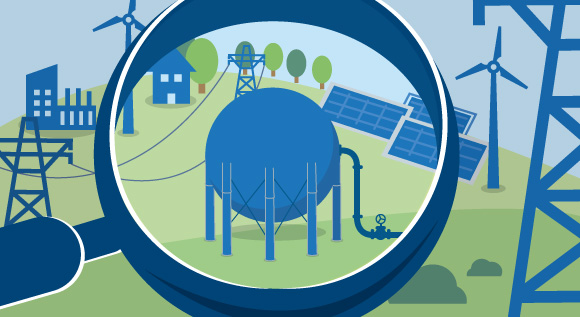What exactly is meant by “sector coupling”?
Apart from the power sector, heating, cooling and transport are other areas in which fossil fuels are to be gradually replaced with renewables. Sector coupling helps to make this possible. Read on to learn more about how this can work in practice.
 © BMWi
© BMWi
It’s about using electricity from renewables for heating, cooling and for driveline technology. The aim is to eliminate the need for fossil fuels.
Last year, electricity from renewables accounted for more than 33 per cent of Germany’s energy consumption. However, its share in the country’s gross final electricity consumption was no more than 13.4 per cent (Q1/2016). So it’s about a third versus a little more than a tenth. Why is it that the share of renewables in our electricity consumption is so much higher?
For the very simple reason that energy is more than just electricity. Energy that is used for heating or transport also counts towards a country’s final energy consumption. Most households as well as the transport sector continue to rely on fossil energy for heating, cooling and mobility.
If we want to bring the energy transition to a long-term success, we cannot stop at transforming the power sector. We must also start using renewables for heating, cooling and transport. This can either be achieved by using renewables directly – for instance by using solar thermal energy to heat a house. Or by using electricity from renewables to bring the energy transition to other sectors. This transfer of clean electricity into other sectors, where it is used to reduce the amount of fossil energy required, is referred to as ‘sector coupling’. Let’s take a closer look at the power, heating, and transport sectors.
Power sector: growing shares of renewables, foreseeable developments, low-cost
Germany has made immense progress when it comes to generating electricity from renewables. In 2010, renewables accounted for 17 per cent of the country’s electricity consumption, the current figure stands at more than 33 per cent. By 2025, the share of renewables is to rise to up to 45 per cent.
The Bundestag and the Bundesrat want to ensure that the further expansion of wind turbine and PV capacity becomes more foreseeable and cost-effective. This is why, on 8 July 2016, they adopted a new version of the Renewable Energy Sources Act (the 2017 version of the Act). The new legislation is also to ensure better synchronisation between the expansion of renewables capacity and the expansion of the grids. You can find out more about this here.
Heating sector: Replacing oil and gas-fired heating systems with electric systems powered by renewables
Germany continues to be a country that mostly relies on fossil fuels like oil and gas for heating. We want this to change. In future, heating will be another area where renewables have a stronger role to play. The magic word here is power-to-heat.
Technologies that convert electricity into heat have massive potential that we can use to make the energy transition a success. They can help us replace fossil fuels with electricity. The greater the share of renewables in the electricity used for this, the more these technologies will help us combat climate change and replace fossil fuels with better alternatives.
Let’s take heat pumps as an example. They use electricity to soak up warmth from the Earth and concentrate it to the point that it can be used to operate the heating system. This is a highly efficient technology. If the building has been retrofitted to be highly energy efficient, a good heat pump will be able to generate several kWh worth of warmth from just one KWh of power.
And if you add inexpensive heat storage to the mix, the whole system becomes even more efficient. This is a perfect way of converting power into heat.
Transport sector: electric mobility fuelled by renewables
The third area in which a great deal of energy is used in Germany is transport. Again, this is a sector that lends itself to electrification. Most trains are already powered by electricity. Recently, the government took action to encourage more drivers to switch over to electric vehicles. A purchase premium for buyers of electric vehicles has been introduced and the charging infrastructure is being expanded. There are trials going to see whether it makes sense to have overhead power lines for trucks on German motorways.
Other non-fossil drives can also deliver green mobility but they require much more electricity. For instance, it is possible for cars to be powered by hydrogen which can be produced by means of electrolysis. This process of turning power into gas can be conducted using electricity from renewables.
It is also becoming more common for heavy-duty vehicles to be powered by liquefied natural gas (LNG). Just like biomethanol, LNG can be used to replace fossil fuels like crude oil. To learn more about how this works, please click here.

